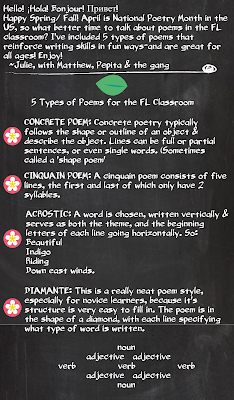OVER THE LAST SEVERAL YEARS I have moved away from whole group instruction as my primary approach in my elementary Spanish classes, incorporating more centers and small group activities. This has been prompted by noting whole group and circle time has become increasingly difficult for kiddos to sustain and be successful in. Prior to the pandemic, I had moved away from circle entirely for third and fourth grade, having them sit in small groups at tables; primary grades started at circle for the beginning of class, then often went to tables/small groups for centers. I have written extensively in Facebook & Twitter posts about this shift and my need to adjust for changes in input, language acquisition, and feeling guilty as a world language teacher that I wasn't providing "optimal instruction".
THE PANDEMIC, ironically, gave me permission to accept the balance in loss of direct input via whole group activities and the benefits of kids engaging in activities in small groups, giving me an opportunity to circulate and interact with individuals. My current approach is a hybrid of whole group for providing a common base, building community, and just being together, along with centers which either feature one specific activity or, more often, a choice basket with multiple activities in them for kids to exercise greater agency in their learning.

CHOICE BASKETS are similar to choice boards in that, obviously, there is CHOICE. The difference, for me, is they are far freer in their expectations on my part, meaning there isn't a required number of activities to complete like is usually the case on a choice board. Instead, kids choose the activities they want to do and can switch out for a new one at any time. I particularly prefer choice baskets for my early elementary grades- Kindergarten, First, and Second Grade. However, this coming year I am looking to extend this into Third and Fourth Grade.
INDEPENDENCE WHEN ENGAGING IN THE CHOICE BASKETS, and centers for that matter, is crucial to me being able to circulate and interact with kids. Some activities lend themselves far better to independent engagement and learning than others; here is a list of ones that are particularly successful with my kiddos:
*PUZZLES: these are always a HUGE hit! Whether they merely need to be solved, such as the mini puzzles I have available in a number of my theme packs, or ones where there is a literacy component that taps into vocabulary practice, puzzles are perfect for kids & need little instruction for them to get started. You can find mini puzzles as part of many theme packs, including
Buenos días Buenas noches Theme Pack ,
Emotions Activity Set ,
Los colores del otoño Theme Pack amongst others! The number puzzles you see below are found in our
Granja Farm Theme Pack.
*MEMORY GAMES: another popular activity is Memory! An easy game for kids to play in small groups or with a partner, there are endless ways to incorporate and practice vocabulary.
*WORD/ LETTER WORK: Magnetic letters and word cards for spelling are a great literacy building activity! I have a number of sets of these, with picture cards connected to the spelling activities, providing opportunities for kids to match the word and the image together as part of each card completion. You can find the ones shown below in our
Venezuela Centers Pack We also have them as part of our
Las Frutas Centers Pack and our
Buenos días Buenas noches Theme Pack
*ACROSTIC PUZZLES: Another take on puzzles, these are great for upper elementary students! I make sure that images are included in my acrostic puzzles so that there is an additional component of not just solving the words, but matching an image to the word for comprehension. The one shown in the photo below is part of our Olivia hace salsa Theme Pack which you can find
here ; our
Pepita lee sobre Nina Gualinga Theme Pack also has one connected to the book La selva de Zonia by Juana Martinez Neal and features rainforest animals. And don't miss the word building acrostic in our
Emotions Activity Set!
*I SEE I WONDER ACTIVITIES: Exploration with authentic realia, items from nature, photos, and/or other objects is another great way for kids to independently follow their curiosity-providing word cards, talking bubbles, or other written prompts to aid and support an incorporation of the target language fosters a bilingual approach. For example, having color word cards available while a student is looking at feathers and a nest can encourage them to "label" the items as they look at them-as you circulate, you can also use the cards when you are interacting with the student, prompting them in the moment to choose cards that connect with the items they are exploring. The word wall cards included in the non fiction issues of our magazine, Mira el Mundo Jr are great for this, such as in
El quetzal Abril 2020!
*COLOR BY NUMBER: these are always popular with kids and are perfect for color word practice-you can find several in my
15 Activities for Upper Elementary Pack which feature cultural elements of a variety of places.
*READ ALOUDS: I try to always have a read aloud available on an Ipad for kids to listen to/watch-whether I create a recording myself of a book or use one found on Youtube, these are a wonderful way for kids to hear a book you might not have time to read in class. When looking for read alouds on Youtube, I only choose those which are either read by the author or have been sanctioned by the publisher so that copyright isn't infringed upon. I have collected a bunch of links on my
Pinterest here so you don't have to do the searching! Click on the section "Read Alouds" to find bunches!
There are so many more activities, but I hope this gives you a great start! What would you add? Share in the comments below!






















